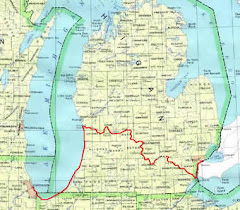I have had difficulty trying to sort out the various Newsletter entries by Verlen, Valerie, Valerie's brother Jon who constituted the land team, and the Editor in order to follow their route after Marquette. Valerie's is the most helpful.
Valerie: "When we arrived in Au Train, to paddle south through the Upper peninsula, we found the river frozen. The basin was a sheet of ice and the Whitefish was frozen into Little Bay de Noc...With the assistance of Jack McHugh, we portaged the iced-in portion of our route and put our canoes into Little Bay de Noc". I take that to mean they put their canoes on McHugh's truck at the Lake Superior shore at Au Train and rode across the UP to somewhere above Gladstone where they found open water.
Valerie continues: "As we paddled into Lake Michigan on November 15 I wondered if we had made a mistake even considering to continue our expedition. Little Bay de Noc was frozen several hundred feet from shore, making landing impossible...One of the turning points of our journey came when we landed near Stonington. We were paddling into Big Bay de Noc, and, as we had hoped, there was no ice formed on th exposed shore." Next morning the snow stopped and they were able to paddle on to Manistique Harbor. The harbor froze over that night so they had to use Verlen's Sea Wind as an ice-breaker to get out to to Lake Michigan in the morning.
Valerie again: "We did continue - across the Straits of Mackinac, into Lake Huron, down the eastern shore of Lower Michigan, past Rogers City, Alpena, Harrisville and Oscoda before we were stopped again, waiting on weather to make the crossing of Saginaw Bay." Because they had schedule commitments they couldn't wait so they portaged around Saginaw Bay to Harbor Beach. She didn't say how. There they resumed paddling. "At Port Sanilac, we came ashore just at dark. We had paddled 30 miles since dawn and had to break ice from our spray covers to climb onto the public dock..."
They continued south, paddling each day and making presentations each night at towns along the shore including Port Huron and Detroit, where they stayed several days before continuing on to Lake Erie, the Maumee and the portage to the Wabash and points south that I have already covered.
I am now going to go back to Marquette and mount my virtual helicopter and follow their path to Detroit where I started out following them in the first message in this series. This will be the last as I don't intend to follow them to Florida, the Caribbean or South America. If someone else would take on that chore I would be most pleased.
This has been an effort in memory of Verlen and in support of Valerie in her fight for life.

